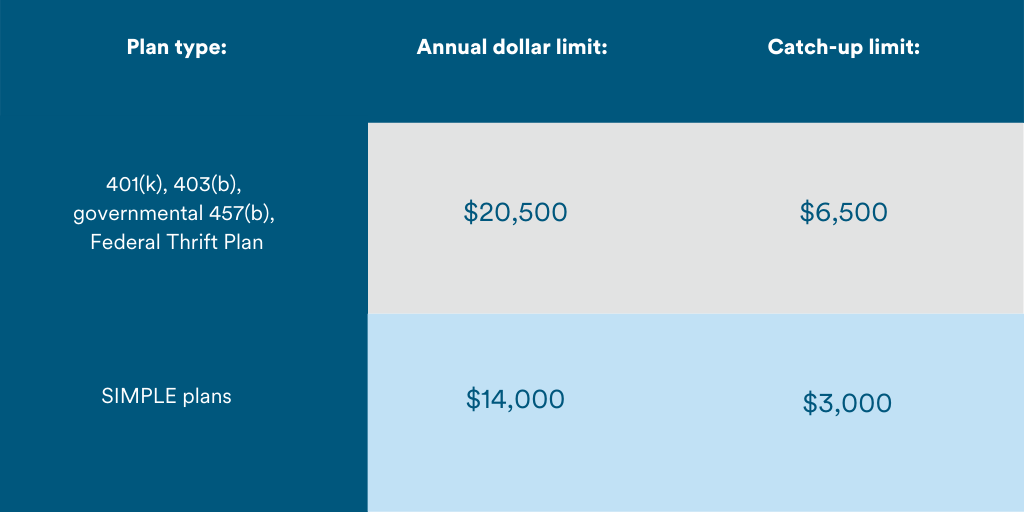How much are you saving for retirement? It’s essential to know how much you can contribute to your IRA, Roth IRA and employer retirement plans. Limits can change year to year. Read on to see what’s changed in 2022.
The maximum amount you can contribute to a traditional IRA or a Roth IRA in 2022 is $6,000 (or 100% of your earned income, if less), unchanged from 2021. The maximum catch-up contribution for those age 50 or older remains at $1,000. You can contribute to both a traditional IRA and a Roth IRA in 2022, but your total contributions can’t exceed these annual limits.
Can you deduct your traditional IRA contributions?
If you (or if you’re married, both you and your spouse) are not covered by a work-based retirement plan, your contributions to a traditional IRA are generally fully tax deductible.
If you’re married, filing jointly, and you’re not covered by an employer plan but your spouse is, your deduction is limited if your modified adjusted gross income (MAGI) is between $204,000 and $214,000 (up from $198,000 and $208,000 in 2021) and eliminated if your MAGI is $214,000 or more (up from $208,000 in 2021).
For those who are covered by an employer plan, deductibility depends on income and filing status. If your filing status is single or head of household, you can fully deduct your IRA contribution in 2022 if your MAGI is $68,000 or less (up from $66,000 in 2021). If you’re married and filing a joint return, you can fully deduct your contribution if your MAGI is $109,000 or less (up from $105,000 in 2021). For taxpayers earning more than these thresholds, the following phaseout limits apply.

Can you contribute to a Roth?
The income limits for determining whether you can contribute to a Roth IRA will also increase in 2022. If your filing status is single or head of household, you can contribute the full $6,000 ($7,000 if you are age 50 or older) to a Roth IRA if your MAGI is $129,000 or less (up from $125,000 in 2021). And if you’re married and filing a joint return, you can make a full contribution if your MAGI is $204,000 or less (up from $198,000 in 2021). For taxpayers earning more than these thresholds, the following phaseout limits apply.

How much can you save in a work-based plan?
If you participate in an employer-sponsored retirement plan, you may be pleased to learn that you can save even more in 2022. The maximum amount you can contribute (your “elective deferrals”) to a 401(k) plan will increase to $20,500 in 2022. This limit also applies to 403(b) and 457(b) plans, as well as the Federal Thrift Plan. If you’re age 50 or older, you can also make catch-up contributions of up to $6,500 to these plans in 2022 (unchanged from 2021). [Special catch-up limits apply to certain participants in 403(b) and 457(b) plans.]
The amount you can contribute to a SIMPLE IRA or SIMPLE 401(k) will increase to $14,000 in 2022, and the catch-up limit for those age 50 or older remains $3,000. Note: Contributions can’t exceed 100% of your income.
If you participate in more than one retirement plan, your total elective deferrals can’t exceed the annual limit ($20,500 in 2022 plus any applicable catch-up contributions). Deferrals to 401(k) plans, 403(b) plans, and SIMPLE plans are included in this aggregate limit, but deferrals to Section 457(b) plans are not. For example, if you participate in both a 403(b) plan and a 457(b) plan, you can save the full amount in each plan — a total of $41,000 in 2022 (plus any catch-up contributions).
The maximum amount that can be allocated to your account in a defined contribution plan [for example, a 401(k) plan or profit-sharing plan] in 2022 is $61,000 (up from $58,000 in 2021) plus age 50 or older catch-up contributions. This includes both your contributions and your employer’s contributions. Special rules apply if your employer sponsors more than one retirement plan.

Finally, the maximum amount of compensation that can be taken into account when determining benefits for most plans in 2022 is $305,000 (up from $290,000 in 2021), and the dollar threshold for determining highly compensated employees (when 2022 is the look-back year) will increase to $135,000 (up from $130,000 in 2021).
If you have questions about how these limits affect you and your retirement planning, contact a CFS* Wealth Management Advisor today. Please give us a call at 303.443.4672 x2240 to set up a no-obligation appointment to discuss your options further.


